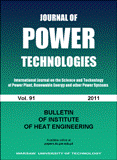A comparative assessment of hydrogen production technologies and its storage
Abstract
This paper represents a review of hydrogen production systems using different methods, showing the importance and many parameters involved in producing hydrogen gas. Methodologies that are included in this review paper are water electrolysis, alkaline electrolysis, thermochemical water splitting, biomass, catalytic generation of hydrogen by ZrO2, polyethylene glycol, geothermal energy, wind energy, niobium-based photo catalyst, natural gas, artificial leaf, and biological production. Water electrolysis involves electricity breaking the water molecule into oxygen and hydrogen. A power supply is given to both positive and negative electrodes, dipped into the electrolyte and in alkaline electrolysis, an aqueous potassium hydroxide solution is used. The following method is thermo-chemical water splitting, a cycle loop of reactions with no greenhouse gas emission. It requires a high temperature to split the water molecule into oxygen and hydrogen. Biomass is a friendly method in which a low biomass concentration is used to avoid the polymerization of products. Zirconia is a catalyst used to increase the rate of gasification in biomass technology. Zirconia is also used in another method to degrade the polyethylene glycol in Inconel at high temperatures to produce hydrogen. Another reliable method used to produce hydrogen is the geothermal energy method which requires a PEM electrolyzer and is operated at a specific temperature range. The latest technology, an artificial leaf with a photovoltaic Si junction sandwiched by Co-OEC and NiMoZn catalysts, produced oxygen and hydrogen in the presence of sunlight and water after the formation of hydrogen stored in liquid and solid form by process of absorption and adsorption.
Published
2025-03-28
How to Cite
AFZAL, Maira et al.
A comparative assessment of hydrogen production technologies and its storage.
Journal of Power Technologies, [S.l.], v. 105, n. 1, p. 64 -- 76, mar. 2025.
ISSN 2083-4195.
Available at: <https://papers.itc.pw.edu.pl/index.php/JPT/article/view/1887>. Date accessed: 06 june 2025.
Issue
Section
Energy Conversion and Storage
Authors who publish with this journal agree to the following terms:
- Authors retain copyright and grant the journal right of first publication with the work simultaneously licensed under a Creative Commons Attribution License that allows others to share the work with an acknowledgement of the work's authorship and initial publication in this journal.
- Authors are able to enter into separate, additional contractual arrangements for the non-exclusive distribution of the journal's published version of the work (e.g., post it to an institutional repository or publish it in a book), with an acknowledgement of its initial publication in this journal.
- Authors are permitted and encouraged to post their work online (e.g., in institutional repositories or on their website) prior to and during the submission process, as it can lead to productive exchanges, as well as earlier and greater citation of published work (See The Effect of Open Access).


